
Co-design in aged care is a bit like CDC – we’ve been hearing about it for a long time, but what does it look like in practice and how does it help? And what role should co-design play in the aged care sector?
On Wednesday, May 3rd, Ellis Jones brought together 40 senior managers from aged care and disability providers, retirement living, placement services and architecture firms to address these questions. In the agency’s Realm of Possibilities workshop space, people rolled up their sleeves and got physical for our co-design in aged care event.
Rhod Ellis-Jones set the scene for the evening by challenging participants to get ‘dangerously uninhibited’ and put aside differences in mission or type of company – the focus, he said, was purely on the creation of social value for recipients of care, including workers, families, and communities.
Bridgette Engeler, Director of Swinburne University’s Master of Design course, and her students then led tables through the co-design process as Ellis Jones consultants helped probe three scenarios: the referral process, the family journey and the physical domain of residential aged care homes.
Participants used active listening and affinity mapping to get deep into the emotional and functional context of three customer personas. Then the real fun started as people used Lego to model the journey of users as they responded to the aged care system, context and different actors.
Once time was called, the tables presented what they had learned and the opportunities those learnings represented: all with the focus of ‘improving the health and wellbeing of people engaging with aged and disability care’.
Here’s a snapshot of what they shared.
1. The journey begins way earlier than we might think.
One group noted that, as a community, we don’t plan for aged care in the same way we plan for other possibilities in our lives through insurance, wills, etc. However, we need to look at aged care as a part of the health continuum, and plan for it.
This then poses the questions: When does the journey towards health and wellbeing begin? How can providers of services such as legal and financial advice be relevant and have a positive impact throughout the process?
A co-design approach can assist aged care providers and policy makers to develop workable solutions with partners and advisors in other industries and sectors. The outcome being reduced stress and anxiety when the time comes to consider care.
“Consumers, their families and carers are proactive in preparing for their future care needs and are empowered to do so.”
– The Aged Care Roadmap
2. The referrer dilemma.
Referrers in the aged care system are often in a difficult position. ACAT and assessment teams want to get the best outcome for older people and their families but cannot influence their decisions or recommend the provider they feel is most appropriate.
How do we address this pain point by maintaining the focus on health and wellbeing (and not marketing services to referrers who cannot respond to that approach)? ACAT members work in incredibly stressful situations, so how can the sector co-design better interfaces?
Co-design with referrers will deepen an understanding of interactions to find solutions that don’t lessen the commitment to unbiased advice.
3. Personalisation of experience.
Physical spaces house intangible experiences and are an important part of an individual’s health and wellbeing experience in aged care. People choosing aged care for themselves or for a family member will always consider the building, its interior and surrounds – the actual space and sense of place. Some features will trigger an obvious response or memory, others can be more subtle.
With several architects among our participants, a key question was raised: how can we evolve building design and programming to enable older people to create the experiences they need or want within the constraints of time, money, regulation and risk? Co-design can help architects and providers balance what people want with what can be achieved – and which constraints to challenge.
Personalisation is also a major global trend in retail and manufacturing – maybe there are lessons there for aged care. Could technology play a role? And if so, how?
4. Embracing complexity.
Aged care is complex and challenging. There are many people, processes, and policies in constant evolution. Co-design methods empower the consumer to define needs and preferences. They also enable the various companies and influencers in and around the care continuum to link services, innovate, evolve the market and improve lives.
As Bridgette Engeler and her team of design leadership students demonstrated through the creative and interactive session, co-design techniques ensure providers understand and work alongside consumers to provide services that improve the wellbeing of older people along life’s journey, beyond the goals currently measured and beyond places we usually associate with ‘care’.
Government is increasingly recognising that consultation and co-design is important for the aged care system. As the Minister for Aged Care, the Hon. Ken Wyatt, recently commented in his opening speech at the Aged and Disability Advocacy Australia National Conference:
“Anyone who knows me, understands that I am a strong believer in consultation, co-design and listening to the views of the people who have their feet on the ground in aged care.
“The government doesn’t own the aged care system. It’s something we will build together as we take into consideration the views and experiences of consumers, providers, health professionals and other stakeholders.”
– Minister for Aged Care, Hon Ken Wyatt
Our team came away with some great insights after working to defeat hurdles and build solutions with the other participants. We can now apply these methods in furthering our social impact mission through co-design in aged care.

